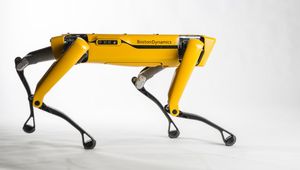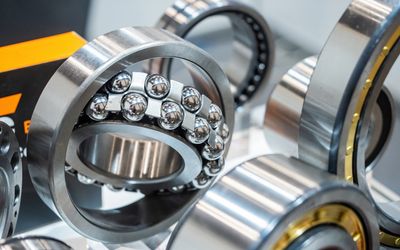Analog Devices OtoSense Smart Motor Sensor
AI-based, high-performance predictive maintenance platform that helps avoid downtime.
General
| Product Type | Sensors |
| Applications | Industrial Automation, Enviromental Monitoring, Artificial Intelligence & Machine Learning, Data Logging & Monitoring |
| Key Features | Vibration Measurement and Data Analysis, AI-Powered Motor Monitoring, Wireless Communication and Power Efficiency |
Technical Specifications
| Product | Smart Motor Sensor |
| Compatibility | 3-Phase Induction Motors (up to 500 kW) |
| Network Standard | Wi-Fi b/g/n |
| Frequency | 2.4 GHz |
| Amplitude Range | ±40 g |
| Battery Type | 4 × Replaceable AA Lithium Batteries |
| Mounting | Cooling Fins |
| Analytics | AI-Powered, Actionable Insights |
Overview
The ADI OtoSense Smart Motor Sensor (SMS) is an AI-based, high-performance predictive maintenance platform designed for revolutionizing electric motor maintenance. It uses sensors, measurement techniques and algorithms to provide actionable insights via measurement of multi-axis vibration, magnetic field and temperature conditions of the motor. Engineered with robust security, this AI-powered sensor provides real-time monitoring and predictive diagnostics for 3-phase induction motors up to 500 kW. By accurately detecting anomalies and predicting maintenance needs, SMS significantly reduces unplanned downtime and operational costs. Compatible with standard low-voltage IEC and NEMA motors across various industries, SMS offers easy installation, low-cost operation, and secure data transmission. Its advanced analytics deliver actionable insights, empowering users to make informed decisions and maximize motor lifespan.
ADI OtoSense Smart Motor Sensor Features
ADI OtoSense Smart Motor Sensor is an AI-based, high-performance predictive maintenance platform that helps avoid downtime and optimize maintenance costs in electric motors. Let’s explore its notable features:
AI-Powered Motor Monitoring
The ADI OtoSense Smart Motor Sensor (SMS) is designed to revolutionize electric motor maintenance through AI-powered technology. It provides real-time monitoring and predictive diagnostics for 3-phase induction motors, offering actionable insights that help detect anomalies early. By identifying potential issues before they lead to costly breakdowns, the SMS optimizes motor performance and significantly reduces downtime. This sensor is compatible with motors up to 500 kW, making it suitable for a wide range of industrial applications.
Broad Compatibility and Flexible Installation
The OtoSense SMS is engineered for broad compatibility with standard low-voltage IEC and NEMA motors. It accommodates frames up to 450 (IEC 60034) or 500 (NEMA MG1), covering a power range from 0.37 kW to 500 kW. Versatile in application, the SMS seamlessly integrates with various motor drive systems, including direct online (DOL), variable frequency drives (VFD), soft starters, and star-delta configurations. Designed for user convenience, the sensor features a compact ABS case with cooling fins for efficient thermal management. Its lightweight design facilitates easy installation in diverse industrial settings.
Vibration Measurement and Data Analysis
The OtoSense SMS excels in precise vibration measurement, capturing data within an amplitude range of ±40 g and a frequency spectrum of 1 Hz to 3.1 kHz. By analyzing both axial and radial vibrations across two axes, the sensor provides comprehensive insights into motor health. Data is presented in waveform, FFT, and RMS formats, enabling a thorough evaluation of motor performance. This detailed vibration analysis empowers users to detect anomalies early, preventing costly breakdowns and optimizing maintenance schedules. The collected data is transmitted wirelessly via Wi-Fi, allowing for continuous remote monitoring and real-time access to critical performance metrics.
Wireless Communication and Power Efficiency
Equipped with robust Wi-Fi b/g/n connectivity operating at 2.4 GHz, the OtoSense SMS ensures reliable data transmission over a range exceeding 50 meters. This wireless capability facilitates seamless integration into existing monitoring systems, providing uninterrupted access to sensor data. To enhance cost-effectiveness and environmental sustainability, the SMS is powered by four replaceable AA lithium batteries, minimizing operational expenses. The sensor's secure design and dependable wireless communication contribute to its overall reliability and efficiency, making it a valuable asset for industrial applications.
Applications
Predictive Maintenance in Automotive Manufacturing
The ADI OtoSense SMS enables predictive maintenance by continuously monitoring motor vibration, temperature, and magnetic field. By analyzing these parameters using AI algorithms, the sensor can detect early signs of bearing wear, rotor imbalance, stator winding faults, and other anomalies. This proactive approach optimizes maintenance schedules, preventing unplanned downtime and reducing repair costs. Additionally, the SMS can identify operational inefficiencies, such as misalignment or overloading, leading to energy savings and improved overall equipment effectiveness (OEE).
Power Generation Industry Application
In power generation, reliability is paramount. The SMS monitors critical motors in turbines, pumps, and compressors, providing early warning of impending failures. By detecting anomalies such as bearing degradation, cavitation, or rotor eccentricity, the sensor helps prevent catastrophic equipment failures and associated blackouts. Furthermore, the SMS can optimize motor performance by identifying load imbalances, misalignment, and other factors affecting efficiency. This leads to reduced energy consumption and lower operating costs.
Paper Industry Application
The paper industry operates in a 24/7 environment where unplanned downtime is extremely costly. The SMS safeguards production by monitoring motors driving critical equipment like paper machines, pulp mixers, and pumps. By detecting issues like bearing wear, rotor imbalance, and cavitation, the sensor prevents unplanned shutdowns and reduces maintenance costs. Additionally, the SMS can optimize motor performance by identifying load variations and energy efficiency opportunities, contributing to overall process improvement and product quality.
Where to find it

Mouser Electronics
Mouser Electronics is a worldwide leading authorized distributor of semiconductors and electronic components.








